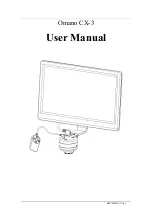
8
TN_US-BA-e-2020
2.2 Description of the control panel
Switching on/off
Calibration
Sound velocity
Background lighting
On/ Off
Enter key
Button f. Reset
Plus;
US mode
On/ Off
Button to change the
Units
Minus;
Beep mode
On/ Off
Save data or
delete
3.
Preparation for commissioning
3.1 Selection of the sound generator
With this instrument a wide range of materials can be measured, from various metals
to glass and plastic. For these different types of materials, different sounders, i.e. US
measuring heads, are required. The correct transducer is crucial for a reliable
measurement result. The following sections explain the important characteristics of the
transducers and what should be considered when selecting a transducer for a specific
work object. Generally speaking, the best transducer for a workobject should send
sufficient ultrasonic energy into the material to be measured so that a strong, stable
echo arrives at the instrument. Certain factors influence the strength of the ultrasound
as it is transmitted.
These can be read in the following:
The initial signal strength: The stronger a signal is from the beginning, the stronger the
returning echo will be. The initial signal strength is mainly a factor of the size of the
ultrasonic emitter in the transducer. A strong emitting surface will emit more energy
into the material than a weak one. Consequently, a so-called "1/2 inch" US probe will
emit a stronger signal than a "1/4 inch" US probe.
Absorption and scattering: When the ultrasound passes through any material, it is
partially absorbed. In materials with a granular structure, the sound waves scatter. Both
of these influences reduce the strength of the sound waves and thus the ability of the
device to detect or record the returning echo. Sound waves with higher frequencies
are more "swallowed" than those with lower frequencies.
So it might seem, it would be better to use a low frequency probe in any case, but
these are less alignable (bundled) than those with high frequencies. Consequently, a







































